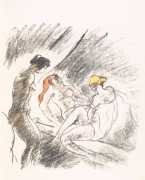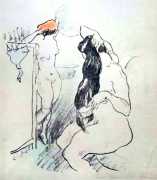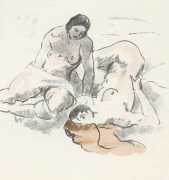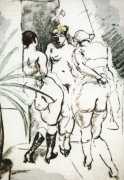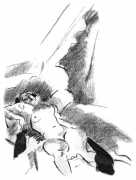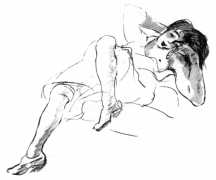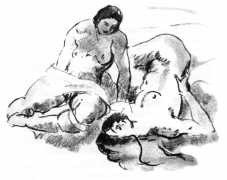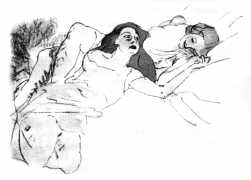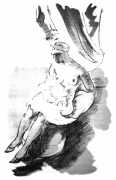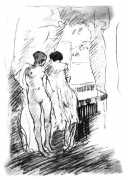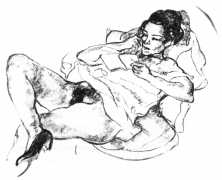
Given that the three most explicitly erotic portfolios produced by Lene Schneider-Kainer during the highly productive Berlin years are all on lesbian themes, it is more than likely that the subject was attractive to her for personal as well as artistic reasons. She was a very close friend of the playwright and poet Else Lasker-Schüler, of whom Lene painted a strong and expressive oil painting in 1915, and Else was well known for her bohemian lifestyle and sexual experimentation.
Early in 1920, probably through an introduction by Wolfgang Gurlitt, Lene Schneider-Kainer was commissioned by Julius Bard Verlag to illustrate a new edition of Lucian’s Hetärengespräche (Dialogues of the Courtesans), using Christoph Martin Wieland’s translation from the original Latin.
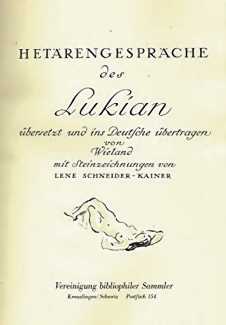 Living at the height of the Roman Empire, the audience Lucian wrote for in Die Hetärengespräche (Dialogues of the Courtesans) was hardly shocked by these short dialogues between Greek prostitutes. However, two millennia of ensuing prudery made it impossible to acknowledge this part of the Lucian corpus, a set of humorous vignettes set in the context of the ‘oldest profession’, let alone translate it into a vernacular language. The comic sketches are timeless: working girls competing for clients, dishing gossip and candid tips of the trade, men trying to keep their girls’ attention with expensive gifts. It also portrays the dark side of the prostitutes’ lives: out-of-control parties, blowhard men, and putting up with rough treatment by clients. The hetaerae of Lucian were not constantly wondering whether their next client was going to flash a badge and haul them off to jail – sex workers in antiquity were just another occupation, like the butcher, the baker and the sandal maker. At that time, pagan temples throughout the eastern Mediterranean had sacred prostitutes, and patronising them was considered a sanctified act. The hetaerae actually had a lot more freedom than other women in Greek society.
Living at the height of the Roman Empire, the audience Lucian wrote for in Die Hetärengespräche (Dialogues of the Courtesans) was hardly shocked by these short dialogues between Greek prostitutes. However, two millennia of ensuing prudery made it impossible to acknowledge this part of the Lucian corpus, a set of humorous vignettes set in the context of the ‘oldest profession’, let alone translate it into a vernacular language. The comic sketches are timeless: working girls competing for clients, dishing gossip and candid tips of the trade, men trying to keep their girls’ attention with expensive gifts. It also portrays the dark side of the prostitutes’ lives: out-of-control parties, blowhard men, and putting up with rough treatment by clients. The hetaerae of Lucian were not constantly wondering whether their next client was going to flash a badge and haul them off to jail – sex workers in antiquity were just another occupation, like the butcher, the baker and the sandal maker. At that time, pagan temples throughout the eastern Mediterranean had sacred prostitutes, and patronising them was considered a sanctified act. The hetaerae actually had a lot more freedom than other women in Greek society.
Hetärengespräche was published by Julius Bard Verlag, in its Vereinigung bibliophiler Sammlung (Association of Bibliophile Collections).


